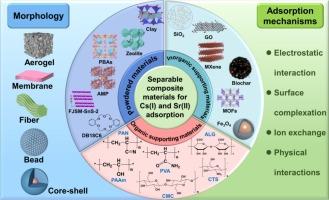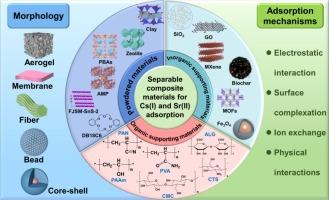Separable composite-based adsorbents for the removal of Cs(I) and Sr(II) from aqueous matrices
IF 23.5
1区 化学
Q1 CHEMISTRY, INORGANIC & NUCLEAR
引用次数: 0
Abstract
Cesium-137 (137Cs) and strontium-90 (90Sr), high-yield radionuclides generated during nuclear energy utilization, inevitably enter the environment through wastewater discharges from nuclear power and nuclear industrial activities, posing potential threats to ecosystems and human health. Therefore, the safe and effective removal of 137Cs and 90Sr from aqueous matrices has become an urgent priority. Various active adsorbents, including clay, zeolites, Prussian blue analogs (PBAs), ammonium phosphomolybdate (AMP), metal sulfides, and crown ethers, have demonstrated effectiveness in removing Cs+ and Sr2+ from aqueous matrices via adsorption techniques. However, their powdered forms pose significant limitations to practical applications in nuclear wastewater treatment. Increasing attention has been directed toward developing composite adsorbents by immobilizing these active materials onto organic or inorganic substrates. This review systematically summarizes recent advances in separable composite adsorbents formed by integrating active adsorbents (clay, zeolites, PBAs, AMP, sulfides, and crown ethers) and emerging materials (graphene oxide, metal-organic frameworks, and MXene) with organic/inorganic carrier materials, with particular emphasis on their structural characteristics, including bead, membrane, aerogel, and fiber forms. The application performance of these composites in Cs+ and Sr2+ removal is evaluated in terms of adsorption capacity, equilibrium time, selectivity, and reusability, accompanied by mechanistic analyses of their adsorption behaviors. Furthermore, the possible adsorption mechanisms of Cs+ and Sr2+ by these composite adsorbents are elucidated, mainly involving electrostatic interactions, surface complexation, ion exchange, and physical interactions. Finally, current challenges and opportunities in the development of composite adsorbents for Cs+ and Sr2+ removal are discussed, and future research directions are proposed for these advanced materials. This work provides valuable insights into the design and development of high-performance composite adsorbents for the remediation of wastewater containing Cs+ and Sr2+.


可分离复合吸附剂去除水中Cs(I)和Sr(II)
核能利用过程中产生的高产量放射性核素铯-137 (137Cs)和锶-90 (90Sr)不可避免地通过核电和核工业活动的废水排放进入环境,对生态系统和人类健康构成潜在威胁。因此,安全有效地去除137Cs和90Sr已成为当务之急。各种活性吸附剂,包括粘土、沸石、普鲁士蓝类似物(PBAs)、磷钼酸铵(AMP)、金属硫化物和冠醚,已经证明了通过吸附技术从水性基质中去除Cs+和Sr2+的有效性。然而,它们的粉末形式对核废水处理的实际应用构成了重大限制。通过将这些活性物质固定在有机或无机基质上来开发复合吸附剂已引起越来越多的关注。本文系统总结了活性吸附剂(粘土、沸石、PBAs、AMP、硫化物和冠醚)和新兴材料(氧化石墨烯、金属有机框架和MXene)与有机/无机载体材料相结合形成的可分离复合吸附剂的最新进展,特别强调了它们的结构特征,包括珠状、膜状、气凝胶和纤维形式。从吸附量、平衡时间、选择性和可重复使用性等方面评价了复合材料在去除Cs+和Sr2+中的应用性能,并对其吸附行为进行了机理分析。进一步阐明了复合吸附剂吸附Cs+和Sr2+的可能机理,主要包括静电相互作用、表面络合作用、离子交换作用和物理相互作用。最后,讨论了目前复合吸附材料去除Cs+和Sr2+面临的挑战和发展机遇,并提出了这些先进材料未来的研究方向。这项工作为设计和开发用于修复含Cs+和Sr2+废水的高性能复合吸附剂提供了有价值的见解。
本文章由计算机程序翻译,如有差异,请以英文原文为准。
求助全文
约1分钟内获得全文
求助全文
来源期刊

Coordination Chemistry Reviews
化学-无机化学与核化学
CiteScore
34.30
自引率
5.30%
发文量
457
审稿时长
54 days
期刊介绍:
Coordination Chemistry Reviews offers rapid publication of review articles on current and significant topics in coordination chemistry, encompassing organometallic, supramolecular, theoretical, and bioinorganic chemistry. It also covers catalysis, materials chemistry, and metal-organic frameworks from a coordination chemistry perspective. Reviews summarize recent developments or discuss specific techniques, welcoming contributions from both established and emerging researchers.
The journal releases special issues on timely subjects, including those featuring contributions from specific regions or conferences. Occasional full-length book articles are also featured. Additionally, special volumes cover annual reviews of main group chemistry, transition metal group chemistry, and organometallic chemistry. These comprehensive reviews are vital resources for those engaged in coordination chemistry, further establishing Coordination Chemistry Reviews as a hub for insightful surveys in inorganic and physical inorganic chemistry.
 求助内容:
求助内容: 应助结果提醒方式:
应助结果提醒方式:


